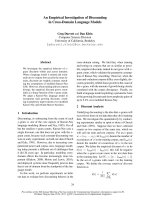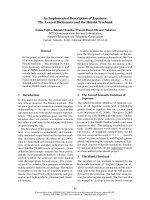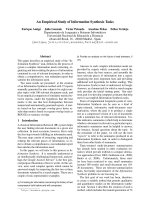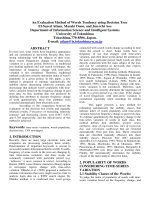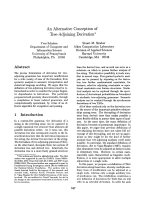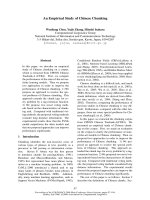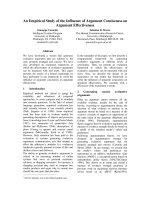Báo cáo khoa học: "An atypical case of respiratory actinobacillosis in a cow" pot
Bạn đang xem bản rút gọn của tài liệu. Xem và tải ngay bản đầy đủ của tài liệu tại đây (3.1 MB, 3 trang )
JOURNAL OF
Veterinary
Science
Case Report
J. Vet. Sci. (2009), 10(3), 265
267
DOI: 10.4142/jvs.2009.10.3.265
*Corresponding author
Tel: +39-051-2097969; Fax: +39-051-2097967
E-mail:
An atypical case of respiratory actinobacillosis in a cow
Peli Angelo
1
, Spadari Alessandro
1
, Romagnoli Noemi
1
, Bettini Giuliano
2,*
, Scarpa Filippo
2
, Pietra Marco
1
Departments of
1
Veterinary Clinical Sciences, and
2
Veterinary Public Health and Animal Pathology, Faculty of Veterinary
Medicine, Alma Mater Studiorum - University of Bologna, Italy
A not pregnant 4-year-old Jersey cow was presented
with the sudden appearance of respiratory noise, nasal
discharge and moderate respiratory difficulty. Upon
physical examination a snoring-like noise, extended head
and neck position, exaggerated abdominal effort, bilateral
nasal discharge and left prescapular lymph node enlargement
were noted. Sub-occlusion of the initial portion of the
respiratory tract was suspected. Radiographic and endoscopic
examinations revealed a pedunculate mass on the dorsal
aspect of the rhinopharynx, which was removed with
endoscopically assisted electrosurgery. Histologic examination
revealed a chronic pyogranulomatous inflammation with
eosinophilic club-like bodies surrounding small colonies of
rod-shaped bacteria. Results of histochemical staining
were consistent with Actinobacillus-like bacteria and a
diagnosis of respiratory actinobacillosis was reached.
Surgery and antibiotic therapy were resolutive, as
demonstated by an endoscopic check at the second month
after surgery, even without the association of the traditional
iodine cure, which is regarded as the treatment of choice
for actinobacillosis.
Keywords:
actinobacillosis, cattle, endoscopy, rhinopharynx,
surgical technique
Actinobacillus (A.) lignieresii, a Gram-negative bacterium
often found as a commensal in the upper digestive tract of
cattle and sheep [1,4,7-10], may be responsible for the
sporadic infection of soft tissues with regional lymph node
involvement. In cattle, ‘wooden tongue’ is the classical
presentation of this infection, in which soft tissue
granulomas develop around the head, pharyngeal, chest,
flank, stomach and limb regions [1,5,7,9,11].
The infection, which can also sometimes take on
epidemic characteristics [2,3,5,6], develops following
trauma that is capable of altering the integrity of the barrier
of the oral mucosa [2] or the skin [5]. The cause is also
sometimes of iatrogenic origin [3,9]. Besides these forms
described in the literature, cases involving atypical
locations have also been described in which actinobacillary
lesions develop in various organs [10,11]. This short
communication describes the clinical, radiological,
endoscopic and pathological findings, and the surgical
treatment of a case of atypical actinobacillosis in a cow.
A 4-year-old female Jersey bovine who was not pregnant,
and had been born and raised at the Department of
Veterinary Clinical Sciences, Faculty of Veterinary
Medicine, University of Bologna, was examined following
the sudden appearance of respiratory noise, nasal discharge
and moderate respiratory difficulty.
Clinical examination demonstrated a snoring-like noise
in the inspiratory phase, extended head and neck position,
exaggerated abdominal effort and a dense, whitish
mucous-like bilateral nasal discharge. Moreover, the left
prescapular lymph node was moderately enlarged.
Sub-occlusion of the initial portion of the respiratory tract
was suspected.
Hemochromocytometric and hematobiochemical analyses
were unremarkable. X-ray examinations of the head, with
a latero-lateral projection, showed the presence of a 10
cm-diameter mass at the rhinopharynx level (Fig. 1). Nasal
endoscopy utilizing a model 780EG apparatus (Pentax
Italia, Italy) was carried out after sedation with 0.025
mg/kg xylazine hydrochloride (Rompum; Bayer, Germany),
0.002 mg/kg butorphanol (Dolorex; Intervet-Schering
Plough Animal Health, The Netherlands) and 1.5 mg/kg
ketamine (Ketavet; Intervet-Schering Plough Animal
Health, The Netherlands). A 5 × 10 cm reddish pedunculate
mass covered with dense whitish mucous material was
identified on the dorsal aspect of the rhinopharynx.
Laryngeal access was partially obstructed during the
inspiratory phase. Using a retroversion movement of the
endoscope, it was possible to visualize the caudal portion
of the mass from the laryngeal side. The mass displayed a
rounded appendix. Radiographic and endoscopic results
confirmed the clinical suspicion and the anatomic location
of the lesion, but could not determine the nature of the
266 Peli Angelo et al.
Fig. 2. Rhinopharyngeal actinogranuloma. The mass is compose
d
of fibrous tissue and multiple confluent pyogranuloma. H&E stain,
×100.
Fig. 3. Actinobacillar pyogranuloma. Bacterial colonies are
surrounded by eosinophilic club-like bodies, neutrophils, an
d
large macrophages. H&E stain, ×400.
Fig. 1. Radiographic appearance of the head, latero-lateral
p
rojection. A mass is evident at the rhinopharynx level (arrows).
neoformation, namely neoplastic or inflammatory, which,
due to its position, required surgery.
Surgery was performed under sedation (as above) and
truncal anesthesia of the two mandibular nerves by local
infiltration of lidocaine hydrochloride as a 2% lidocaine
solution (Azienda Terapeutica Italiana, Italy). Endoscopically
assisted electrosurgery allowed partial remove of the mass,
which was definitely resected by manual grasping through
the oral cavity.
The defect was tamponed with iodopovidone (Betadine;
Viatris, Italy), maintaining the head low to avoid
aspiration. During the following three days the animal was
treated with daily intramuscular injections of 30 mL
benzylpenicillin and dihydrostreptomycin (Combiotic;
Pfizer Animal Health, USA) and 1 mg/kg of flunixin
meglumine (Finadyne; Shering Plough Animal Health,
The Netherlands).
The cow showed sudden remission of the respiratory
symptoms. Moderate hyperthermia (39.5
o
C) was recorded
only in first day after surgery. An endoscopic check in the
second month after surgery showed a small thick scar of the
mucosa and no recurrence.
Histopathology of hematoxylin and eosin stained
sections from formalin-fixed and paraffin-embedded
samples demonstrated that the mass was composed of
fibrous tissue and multiple confluent pyogranulomas
containing small colonies of rod-shaped bacteria surrounded
by eosinophilic club-like bodies (Figs. 2 and 3). Gram and
Ziehl-Neelsen stains for acid-fast organisms were then
carried out; results were Gram-negative and non-acid-fast,
respectively. Accordingly, a histological diagnosis of
chronic pyogranulomatous inflammation caused by
Actinobacillus-like bacteria (probably A. lignieresii) was
reached.
In this case, the respiratory symptoms manifested by the
animal did not offer any particular difficulty in formulating
a diagnosis of location, which was easily confirmed by
endoscopy. The differential diagnosis for obstructive
endopharyngeal diseases includes abscesses of the
retropharyngeal lymph nodes, fibropapillomas, viral
papillomas and infectious (tubercular or actinobacillar),
allergic, mycotic or parasitic granulomas. Histopathology
is the procedure of choice for their differentiation.
Although definitive diagnosis relies on culture, the lesion
pattern and the morphology of bacteria colonies were
strongly suggestive of A. lignieresii infection, as their
staining properties, size and shape excluded other organisms
capable of causing granulomas (e.g. Mycobacteria spp.) or
pyogranulomas (e.g. Actinomyces bovis, Staphylococcus
aureus). As in granulomatous glossitis, the bacteria were
putatively carried by a foreign body, probably a vegetal,
although no remnants were evident histologically.
The endoscopic surgery represented a valid option for the
removal of the mass associated with hemostasis, even if its
position and the dimensions made a double surgical
approach necessary.
Respiratory actinobacillosis in a cow 267
Furthermore, the resolutive character of the surgical
therapy, as demonstrated by the endoscopic check at the
second month after surgery, is noteworthy since it was
reached without the association of the “iodine cure”
doctrinally described as the treatment of choice for
actinobacillosis [12].
References
1. Aslani MR, Khodakaram A, Rezakhani A. An atypical
case of actinobacillosis in a cow. J Vet Med A 1995, 42,
485-488.
2. Campbell SG, Whitlock TRH, Timoney JF, Underwood
AM. An unusual epizootic of actinobacillosis in dairy
heifers. J Am Vet Med Assoc 1975, 166, 604-606.
3. de Kruif A, Mijten P, Haesebrouck F, Hoorens J,
Devriese L. Actinobacillosis in bovine caesarean sections.
Vet Rec 1992, 131, 414-415.
4. Gottschalk M. Actinobacillus species in animal disease: a
topical subject. Vet J 2000, 159, 5-7.
5. Hebeler HF, Linton AH, Osborne AD. Atypical
actinobacillosis in a dairy herd. Vet Rec 1961, 73, 517- 521.
6. Julini M, Cravero G. Actinogranulomatosi linfonodale in
vitelloni da carne. Prog Vet 1979, 34, 1151-1152.
7. Milne MH, Barrett DC, Mellor DJ, O’neill R, Fitzpatrick
JL. Clinical recognition and treatment of bovine cutaneous
actinobacillosis. Vet Rec 2001, 148, 273-274.
8. Radostits OM, Gay CC, Blood DC, Hinchcliff KW.
Veterinary Medicine: A Textbook of the Diseases of Cattle,
Sheep, Pigs, Goats and Horses. 9th ed. pp. 909-944,
Saunders, London, 2000.
9. Rebhun WC, King JM, Hillman RB. Atypical actinobacillosis
granulomas in cattle. Cornell Vet 1988, 78, 125-130.
10. Rycroft AN, Garside LH. Actinobacillus species and their
role in animal disease. Vet J 2000, 159, 18-36.
11. Smith BP. Large Animal Internal Medicine. 3rd ed. pp.
698-699, Mosby, St. Louis, 2002.
12. Swarbrick O. Atypical actinobacillosis in three cows. Br
Vet J 1967, 123, 70-75.


